Telehealth Report: Analysis of Framework, Barriers, and Strategies
VerifiedAdded on 2022/08/28
|14
|3896
|21
Report
AI Summary
This report provides a comprehensive overview of telehealth, examining its framework, barriers, and strategic approaches within the healthcare landscape. It delves into the various facets of telehealth, including its definition, different types of services such as teleconsultation, telehomecare, and remote patient monitoring, and the impact on healthcare delivery in Canada. The report analyzes the telehealth framework, encompassing governance, clinical practice integration, training, and infrastructure. It also identifies key barriers to telehealth implementation, such as negative perceptions, costs, and resistance to change. Furthermore, the report outlines various strategies to ensure effective telehealth utilization, emphasizing patient-centered care, harm prevention, and evidence-based practices. The content is designed to provide a balanced perspective on the benefits and challenges of telehealth, offering insights into its potential to transform healthcare delivery and improve patient outcomes.
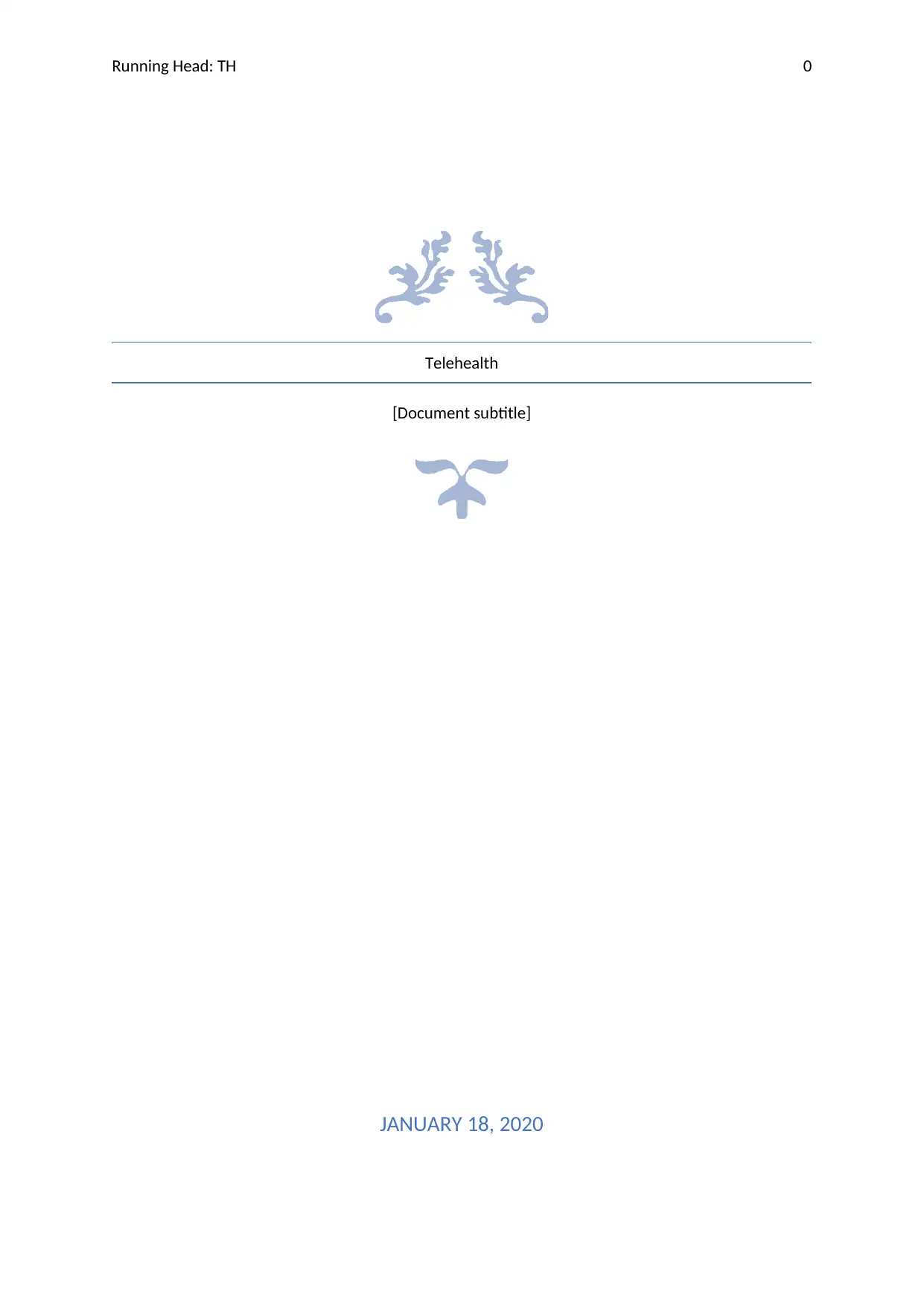
Running Head: TH 0
Telehealth
[Document subtitle]
JANUARY 18, 2020
Telehealth
[Document subtitle]
JANUARY 18, 2020
Paraphrase This Document
Need a fresh take? Get an instant paraphrase of this document with our AI Paraphraser

TH 1
Table of Contents
Introduction...........................................................................................................................................2
Telehealth..........................................................................................................................................3
Framework of telehealth...................................................................................................................4
Barrier of telehealth..........................................................................................................................6
Strategies...........................................................................................................................................7
Conclusion.............................................................................................................................................9
References...........................................................................................................................................11
Table of Contents
Introduction...........................................................................................................................................2
Telehealth..........................................................................................................................................3
Framework of telehealth...................................................................................................................4
Barrier of telehealth..........................................................................................................................6
Strategies...........................................................................................................................................7
Conclusion.............................................................................................................................................9
References...........................................................................................................................................11
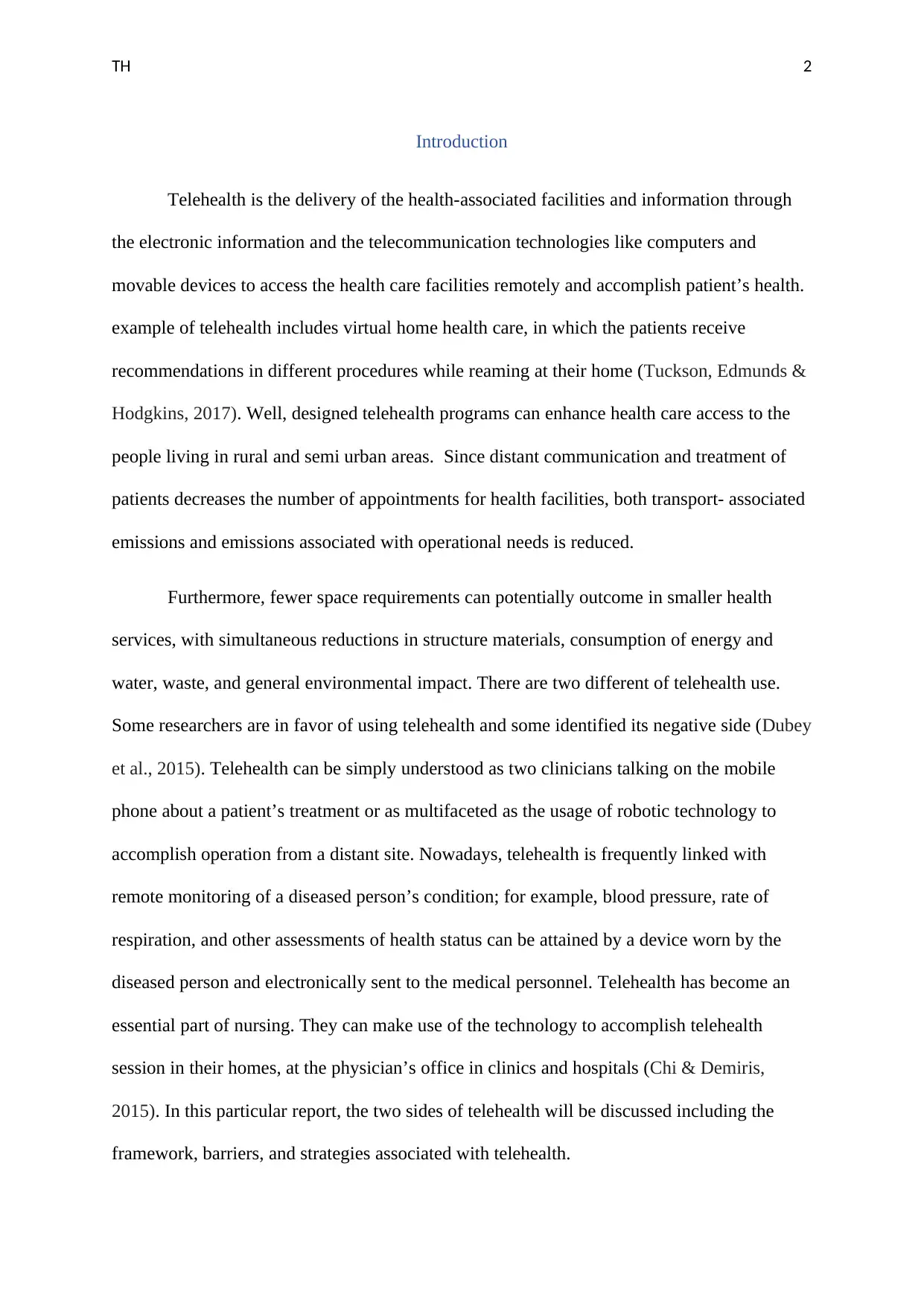
TH 2
Introduction
Telehealth is the delivery of the health-associated facilities and information through
the electronic information and the telecommunication technologies like computers and
movable devices to access the health care facilities remotely and accomplish patient’s health.
example of telehealth includes virtual home health care, in which the patients receive
recommendations in different procedures while reaming at their home (Tuckson, Edmunds &
Hodgkins, 2017). Well, designed telehealth programs can enhance health care access to the
people living in rural and semi urban areas. Since distant communication and treatment of
patients decreases the number of appointments for health facilities, both transport- associated
emissions and emissions associated with operational needs is reduced.
Furthermore, fewer space requirements can potentially outcome in smaller health
services, with simultaneous reductions in structure materials, consumption of energy and
water, waste, and general environmental impact. There are two different of telehealth use.
Some researchers are in favor of using telehealth and some identified its negative side (Dubey
et al., 2015). Telehealth can be simply understood as two clinicians talking on the mobile
phone about a patient’s treatment or as multifaceted as the usage of robotic technology to
accomplish operation from a distant site. Nowadays, telehealth is frequently linked with
remote monitoring of a diseased person’s condition; for example, blood pressure, rate of
respiration, and other assessments of health status can be attained by a device worn by the
diseased person and electronically sent to the medical personnel. Telehealth has become an
essential part of nursing. They can make use of the technology to accomplish telehealth
session in their homes, at the physician’s office in clinics and hospitals (Chi & Demiris,
2015). In this particular report, the two sides of telehealth will be discussed including the
framework, barriers, and strategies associated with telehealth.
Introduction
Telehealth is the delivery of the health-associated facilities and information through
the electronic information and the telecommunication technologies like computers and
movable devices to access the health care facilities remotely and accomplish patient’s health.
example of telehealth includes virtual home health care, in which the patients receive
recommendations in different procedures while reaming at their home (Tuckson, Edmunds &
Hodgkins, 2017). Well, designed telehealth programs can enhance health care access to the
people living in rural and semi urban areas. Since distant communication and treatment of
patients decreases the number of appointments for health facilities, both transport- associated
emissions and emissions associated with operational needs is reduced.
Furthermore, fewer space requirements can potentially outcome in smaller health
services, with simultaneous reductions in structure materials, consumption of energy and
water, waste, and general environmental impact. There are two different of telehealth use.
Some researchers are in favor of using telehealth and some identified its negative side (Dubey
et al., 2015). Telehealth can be simply understood as two clinicians talking on the mobile
phone about a patient’s treatment or as multifaceted as the usage of robotic technology to
accomplish operation from a distant site. Nowadays, telehealth is frequently linked with
remote monitoring of a diseased person’s condition; for example, blood pressure, rate of
respiration, and other assessments of health status can be attained by a device worn by the
diseased person and electronically sent to the medical personnel. Telehealth has become an
essential part of nursing. They can make use of the technology to accomplish telehealth
session in their homes, at the physician’s office in clinics and hospitals (Chi & Demiris,
2015). In this particular report, the two sides of telehealth will be discussed including the
framework, barriers, and strategies associated with telehealth.
⊘ This is a preview!⊘
Do you want full access?
Subscribe today to unlock all pages.

Trusted by 1+ million students worldwide
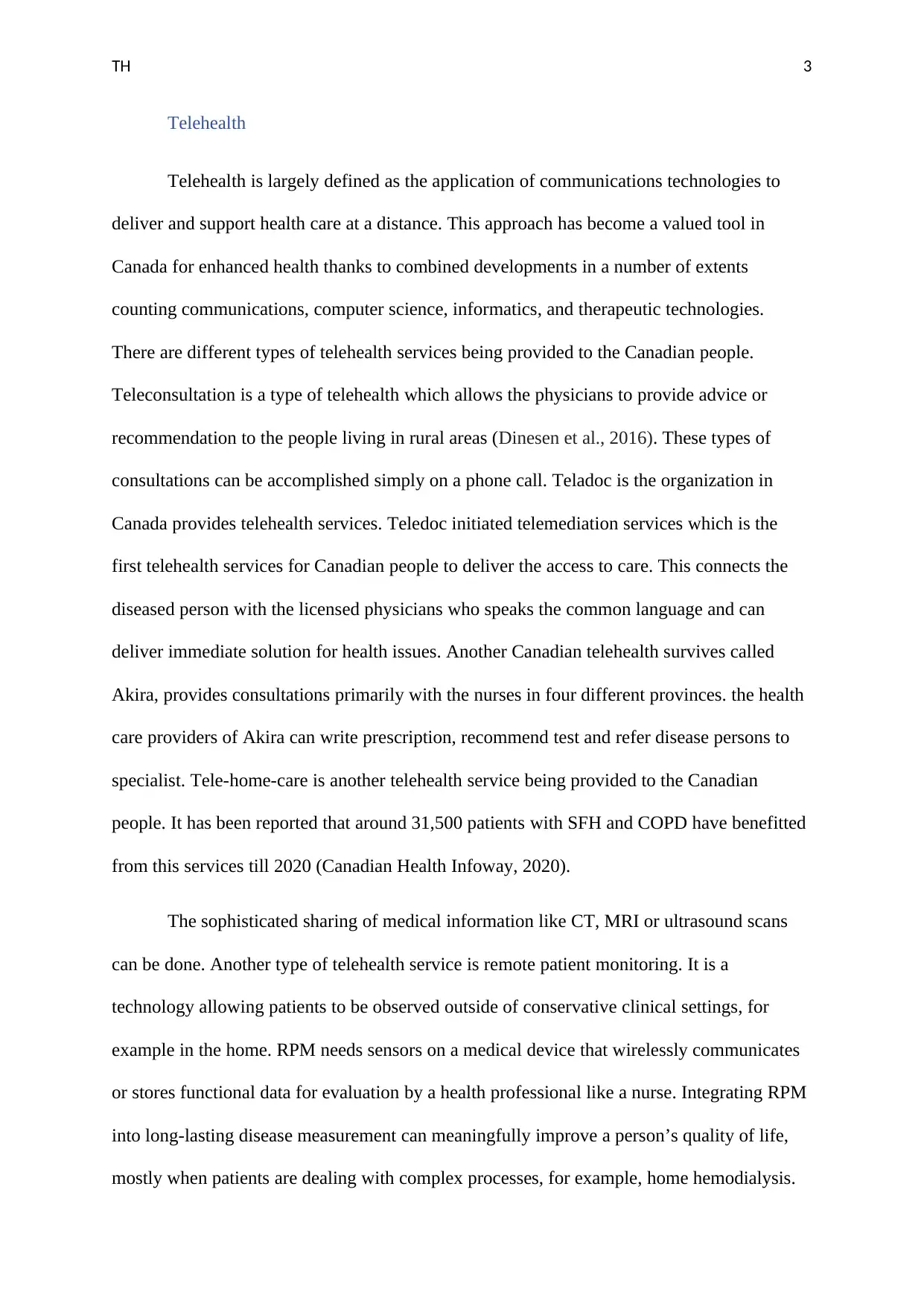
TH 3
Telehealth
Telehealth is largely defined as the application of communications technologies to
deliver and support health care at a distance. This approach has become a valued tool in
Canada for enhanced health thanks to combined developments in a number of extents
counting communications, computer science, informatics, and therapeutic technologies.
There are different types of telehealth services being provided to the Canadian people.
Teleconsultation is a type of telehealth which allows the physicians to provide advice or
recommendation to the people living in rural areas (Dinesen et al., 2016). These types of
consultations can be accomplished simply on a phone call. Teladoc is the organization in
Canada provides telehealth services. Teledoc initiated telemediation services which is the
first telehealth services for Canadian people to deliver the access to care. This connects the
diseased person with the licensed physicians who speaks the common language and can
deliver immediate solution for health issues. Another Canadian telehealth survives called
Akira, provides consultations primarily with the nurses in four different provinces. the health
care providers of Akira can write prescription, recommend test and refer disease persons to
specialist. Tele-home-care is another telehealth service being provided to the Canadian
people. It has been reported that around 31,500 patients with SFH and COPD have benefitted
from this services till 2020 (Canadian Health Infoway, 2020).
The sophisticated sharing of medical information like CT, MRI or ultrasound scans
can be done. Another type of telehealth service is remote patient monitoring. It is a
technology allowing patients to be observed outside of conservative clinical settings, for
example in the home. RPM needs sensors on a medical device that wirelessly communicates
or stores functional data for evaluation by a health professional like a nurse. Integrating RPM
into long-lasting disease measurement can meaningfully improve a person’s quality of life,
mostly when patients are dealing with complex processes, for example, home hemodialysis.
Telehealth
Telehealth is largely defined as the application of communications technologies to
deliver and support health care at a distance. This approach has become a valued tool in
Canada for enhanced health thanks to combined developments in a number of extents
counting communications, computer science, informatics, and therapeutic technologies.
There are different types of telehealth services being provided to the Canadian people.
Teleconsultation is a type of telehealth which allows the physicians to provide advice or
recommendation to the people living in rural areas (Dinesen et al., 2016). These types of
consultations can be accomplished simply on a phone call. Teladoc is the organization in
Canada provides telehealth services. Teledoc initiated telemediation services which is the
first telehealth services for Canadian people to deliver the access to care. This connects the
diseased person with the licensed physicians who speaks the common language and can
deliver immediate solution for health issues. Another Canadian telehealth survives called
Akira, provides consultations primarily with the nurses in four different provinces. the health
care providers of Akira can write prescription, recommend test and refer disease persons to
specialist. Tele-home-care is another telehealth service being provided to the Canadian
people. It has been reported that around 31,500 patients with SFH and COPD have benefitted
from this services till 2020 (Canadian Health Infoway, 2020).
The sophisticated sharing of medical information like CT, MRI or ultrasound scans
can be done. Another type of telehealth service is remote patient monitoring. It is a
technology allowing patients to be observed outside of conservative clinical settings, for
example in the home. RPM needs sensors on a medical device that wirelessly communicates
or stores functional data for evaluation by a health professional like a nurse. Integrating RPM
into long-lasting disease measurement can meaningfully improve a person’s quality of life,
mostly when patients are dealing with complex processes, for example, home hemodialysis.
Paraphrase This Document
Need a fresh take? Get an instant paraphrase of this document with our AI Paraphraser
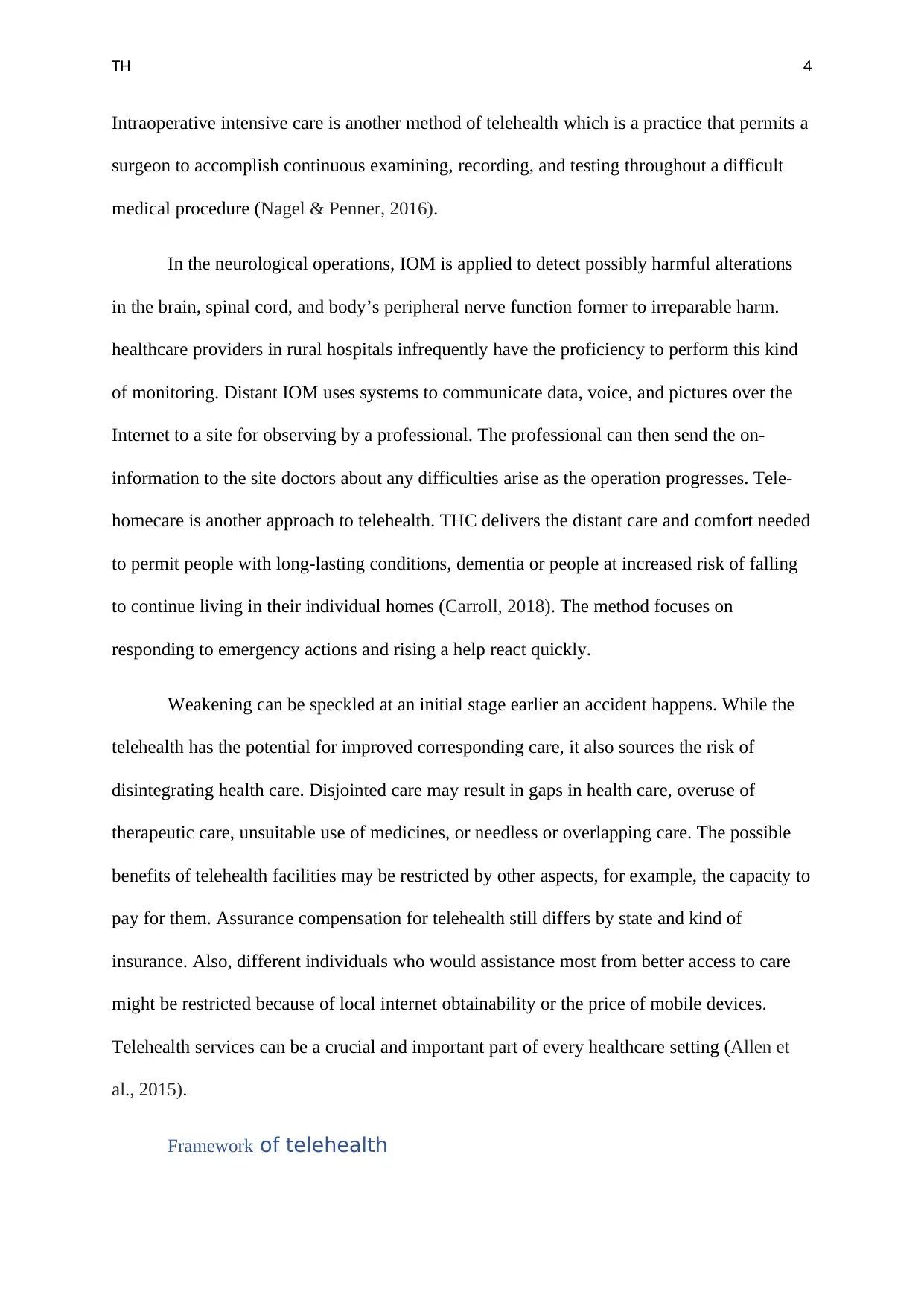
TH 4
Intraoperative intensive care is another method of telehealth which is a practice that permits a
surgeon to accomplish continuous examining, recording, and testing throughout a difficult
medical procedure (Nagel & Penner, 2016).
In the neurological operations, IOM is applied to detect possibly harmful alterations
in the brain, spinal cord, and body’s peripheral nerve function former to irreparable harm.
healthcare providers in rural hospitals infrequently have the proficiency to perform this kind
of monitoring. Distant IOM uses systems to communicate data, voice, and pictures over the
Internet to a site for observing by a professional. The professional can then send the on-
information to the site doctors about any difficulties arise as the operation progresses. Tele-
homecare is another approach to telehealth. THC delivers the distant care and comfort needed
to permit people with long-lasting conditions, dementia or people at increased risk of falling
to continue living in their individual homes (Carroll, 2018). The method focuses on
responding to emergency actions and rising a help react quickly.
Weakening can be speckled at an initial stage earlier an accident happens. While the
telehealth has the potential for improved corresponding care, it also sources the risk of
disintegrating health care. Disjointed care may result in gaps in health care, overuse of
therapeutic care, unsuitable use of medicines, or needless or overlapping care. The possible
benefits of telehealth facilities may be restricted by other aspects, for example, the capacity to
pay for them. Assurance compensation for telehealth still differs by state and kind of
insurance. Also, different individuals who would assistance most from better access to care
might be restricted because of local internet obtainability or the price of mobile devices.
Telehealth services can be a crucial and important part of every healthcare setting (Allen et
al., 2015).
Framework of telehealth
Intraoperative intensive care is another method of telehealth which is a practice that permits a
surgeon to accomplish continuous examining, recording, and testing throughout a difficult
medical procedure (Nagel & Penner, 2016).
In the neurological operations, IOM is applied to detect possibly harmful alterations
in the brain, spinal cord, and body’s peripheral nerve function former to irreparable harm.
healthcare providers in rural hospitals infrequently have the proficiency to perform this kind
of monitoring. Distant IOM uses systems to communicate data, voice, and pictures over the
Internet to a site for observing by a professional. The professional can then send the on-
information to the site doctors about any difficulties arise as the operation progresses. Tele-
homecare is another approach to telehealth. THC delivers the distant care and comfort needed
to permit people with long-lasting conditions, dementia or people at increased risk of falling
to continue living in their individual homes (Carroll, 2018). The method focuses on
responding to emergency actions and rising a help react quickly.
Weakening can be speckled at an initial stage earlier an accident happens. While the
telehealth has the potential for improved corresponding care, it also sources the risk of
disintegrating health care. Disjointed care may result in gaps in health care, overuse of
therapeutic care, unsuitable use of medicines, or needless or overlapping care. The possible
benefits of telehealth facilities may be restricted by other aspects, for example, the capacity to
pay for them. Assurance compensation for telehealth still differs by state and kind of
insurance. Also, different individuals who would assistance most from better access to care
might be restricted because of local internet obtainability or the price of mobile devices.
Telehealth services can be a crucial and important part of every healthcare setting (Allen et
al., 2015).
Framework of telehealth
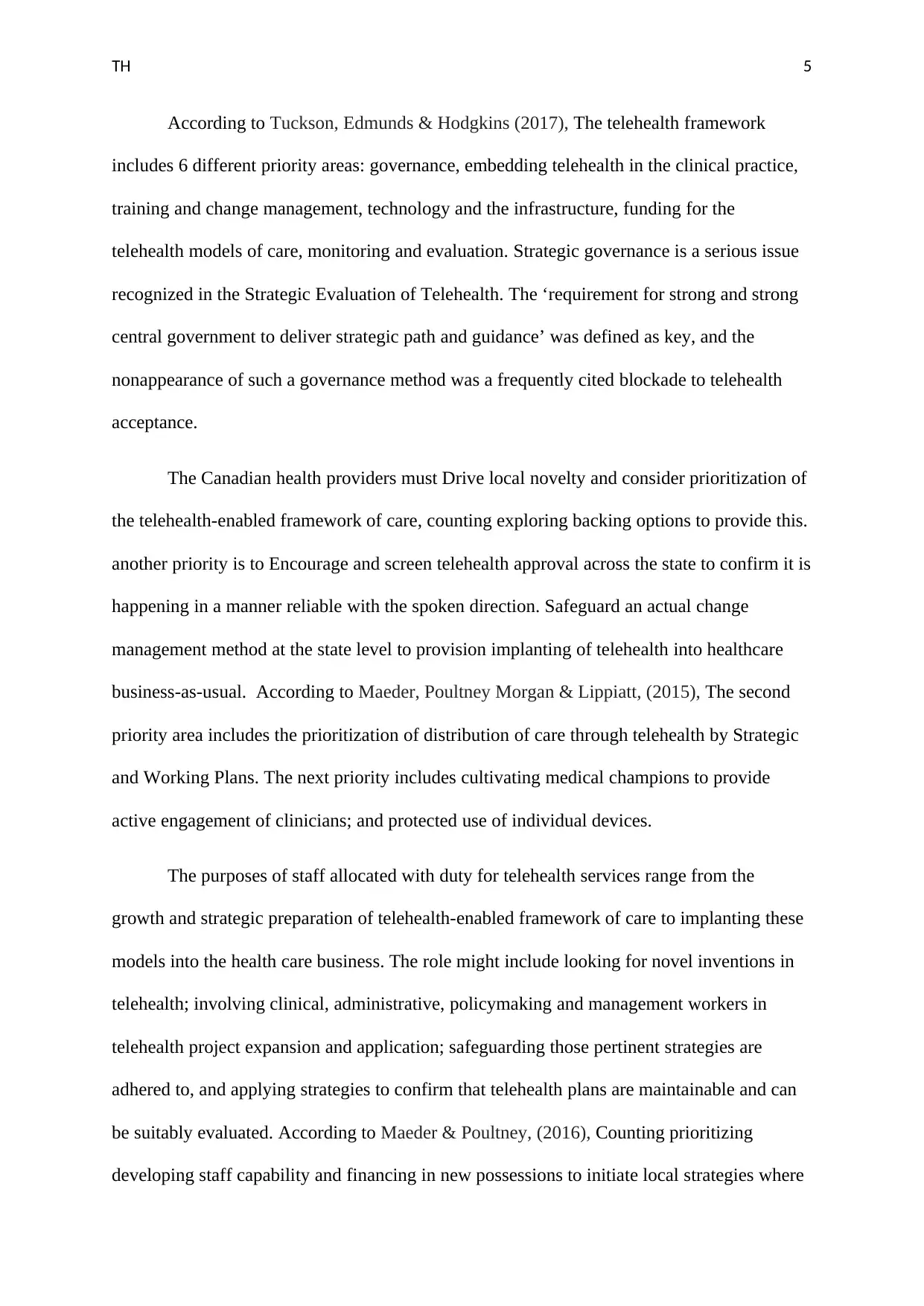
TH 5
According to Tuckson, Edmunds & Hodgkins (2017), The telehealth framework
includes 6 different priority areas: governance, embedding telehealth in the clinical practice,
training and change management, technology and the infrastructure, funding for the
telehealth models of care, monitoring and evaluation. Strategic governance is a serious issue
recognized in the Strategic Evaluation of Telehealth. The ‘requirement for strong and strong
central government to deliver strategic path and guidance’ was defined as key, and the
nonappearance of such a governance method was a frequently cited blockade to telehealth
acceptance.
The Canadian health providers must Drive local novelty and consider prioritization of
the telehealth-enabled framework of care, counting exploring backing options to provide this.
another priority is to Encourage and screen telehealth approval across the state to confirm it is
happening in a manner reliable with the spoken direction. Safeguard an actual change
management method at the state level to provision implanting of telehealth into healthcare
business-as-usual. According to Maeder, Poultney Morgan & Lippiatt, (2015), The second
priority area includes the prioritization of distribution of care through telehealth by Strategic
and Working Plans. The next priority includes cultivating medical champions to provide
active engagement of clinicians; and protected use of individual devices.
The purposes of staff allocated with duty for telehealth services range from the
growth and strategic preparation of telehealth-enabled framework of care to implanting these
models into the health care business. The role might include looking for novel inventions in
telehealth; involving clinical, administrative, policymaking and management workers in
telehealth project expansion and application; safeguarding those pertinent strategies are
adhered to, and applying strategies to confirm that telehealth plans are maintainable and can
be suitably evaluated. According to Maeder & Poultney, (2016), Counting prioritizing
developing staff capability and financing in new possessions to initiate local strategies where
According to Tuckson, Edmunds & Hodgkins (2017), The telehealth framework
includes 6 different priority areas: governance, embedding telehealth in the clinical practice,
training and change management, technology and the infrastructure, funding for the
telehealth models of care, monitoring and evaluation. Strategic governance is a serious issue
recognized in the Strategic Evaluation of Telehealth. The ‘requirement for strong and strong
central government to deliver strategic path and guidance’ was defined as key, and the
nonappearance of such a governance method was a frequently cited blockade to telehealth
acceptance.
The Canadian health providers must Drive local novelty and consider prioritization of
the telehealth-enabled framework of care, counting exploring backing options to provide this.
another priority is to Encourage and screen telehealth approval across the state to confirm it is
happening in a manner reliable with the spoken direction. Safeguard an actual change
management method at the state level to provision implanting of telehealth into healthcare
business-as-usual. According to Maeder, Poultney Morgan & Lippiatt, (2015), The second
priority area includes the prioritization of distribution of care through telehealth by Strategic
and Working Plans. The next priority includes cultivating medical champions to provide
active engagement of clinicians; and protected use of individual devices.
The purposes of staff allocated with duty for telehealth services range from the
growth and strategic preparation of telehealth-enabled framework of care to implanting these
models into the health care business. The role might include looking for novel inventions in
telehealth; involving clinical, administrative, policymaking and management workers in
telehealth project expansion and application; safeguarding those pertinent strategies are
adhered to, and applying strategies to confirm that telehealth plans are maintainable and can
be suitably evaluated. According to Maeder & Poultney, (2016), Counting prioritizing
developing staff capability and financing in new possessions to initiate local strategies where
⊘ This is a preview!⊘
Do you want full access?
Subscribe today to unlock all pages.

Trusted by 1+ million students worldwide
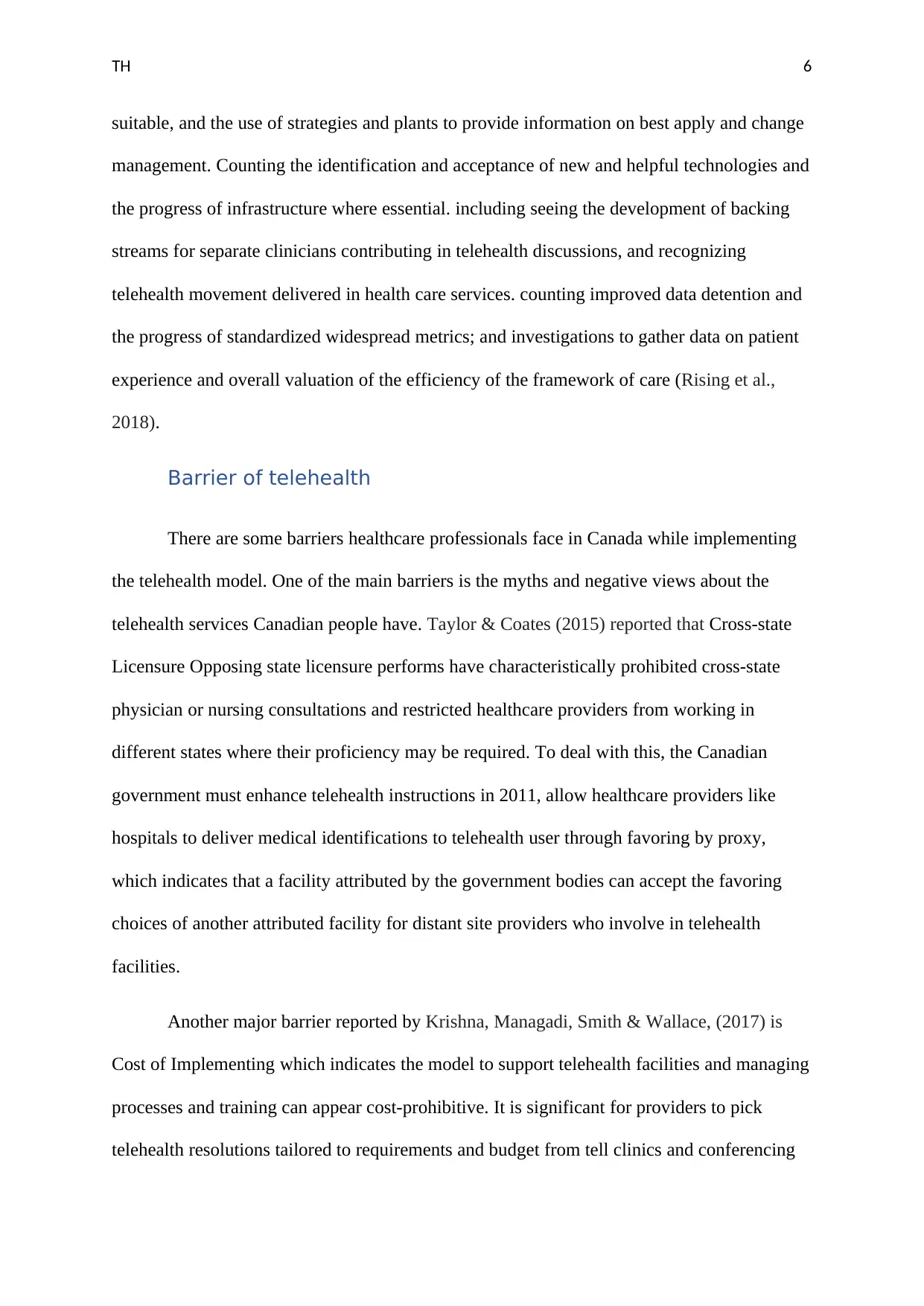
TH 6
suitable, and the use of strategies and plants to provide information on best apply and change
management. Counting the identification and acceptance of new and helpful technologies and
the progress of infrastructure where essential. including seeing the development of backing
streams for separate clinicians contributing in telehealth discussions, and recognizing
telehealth movement delivered in health care services. counting improved data detention and
the progress of standardized widespread metrics; and investigations to gather data on patient
experience and overall valuation of the efficiency of the framework of care (Rising et al.,
2018).
Barrier of telehealth
There are some barriers healthcare professionals face in Canada while implementing
the telehealth model. One of the main barriers is the myths and negative views about the
telehealth services Canadian people have. Taylor & Coates (2015) reported that Cross-state
Licensure Opposing state licensure performs have characteristically prohibited cross-state
physician or nursing consultations and restricted healthcare providers from working in
different states where their proficiency may be required. To deal with this, the Canadian
government must enhance telehealth instructions in 2011, allow healthcare providers like
hospitals to deliver medical identifications to telehealth user through favoring by proxy,
which indicates that a facility attributed by the government bodies can accept the favoring
choices of another attributed facility for distant site providers who involve in telehealth
facilities.
Another major barrier reported by Krishna, Managadi, Smith & Wallace, (2017) is
Cost of Implementing which indicates the model to support telehealth facilities and managing
processes and training can appear cost-prohibitive. It is significant for providers to pick
telehealth resolutions tailored to requirements and budget from tell clinics and conferencing
suitable, and the use of strategies and plants to provide information on best apply and change
management. Counting the identification and acceptance of new and helpful technologies and
the progress of infrastructure where essential. including seeing the development of backing
streams for separate clinicians contributing in telehealth discussions, and recognizing
telehealth movement delivered in health care services. counting improved data detention and
the progress of standardized widespread metrics; and investigations to gather data on patient
experience and overall valuation of the efficiency of the framework of care (Rising et al.,
2018).
Barrier of telehealth
There are some barriers healthcare professionals face in Canada while implementing
the telehealth model. One of the main barriers is the myths and negative views about the
telehealth services Canadian people have. Taylor & Coates (2015) reported that Cross-state
Licensure Opposing state licensure performs have characteristically prohibited cross-state
physician or nursing consultations and restricted healthcare providers from working in
different states where their proficiency may be required. To deal with this, the Canadian
government must enhance telehealth instructions in 2011, allow healthcare providers like
hospitals to deliver medical identifications to telehealth user through favoring by proxy,
which indicates that a facility attributed by the government bodies can accept the favoring
choices of another attributed facility for distant site providers who involve in telehealth
facilities.
Another major barrier reported by Krishna, Managadi, Smith & Wallace, (2017) is
Cost of Implementing which indicates the model to support telehealth facilities and managing
processes and training can appear cost-prohibitive. It is significant for providers to pick
telehealth resolutions tailored to requirements and budget from tell clinics and conferencing
Paraphrase This Document
Need a fresh take? Get an instant paraphrase of this document with our AI Paraphraser
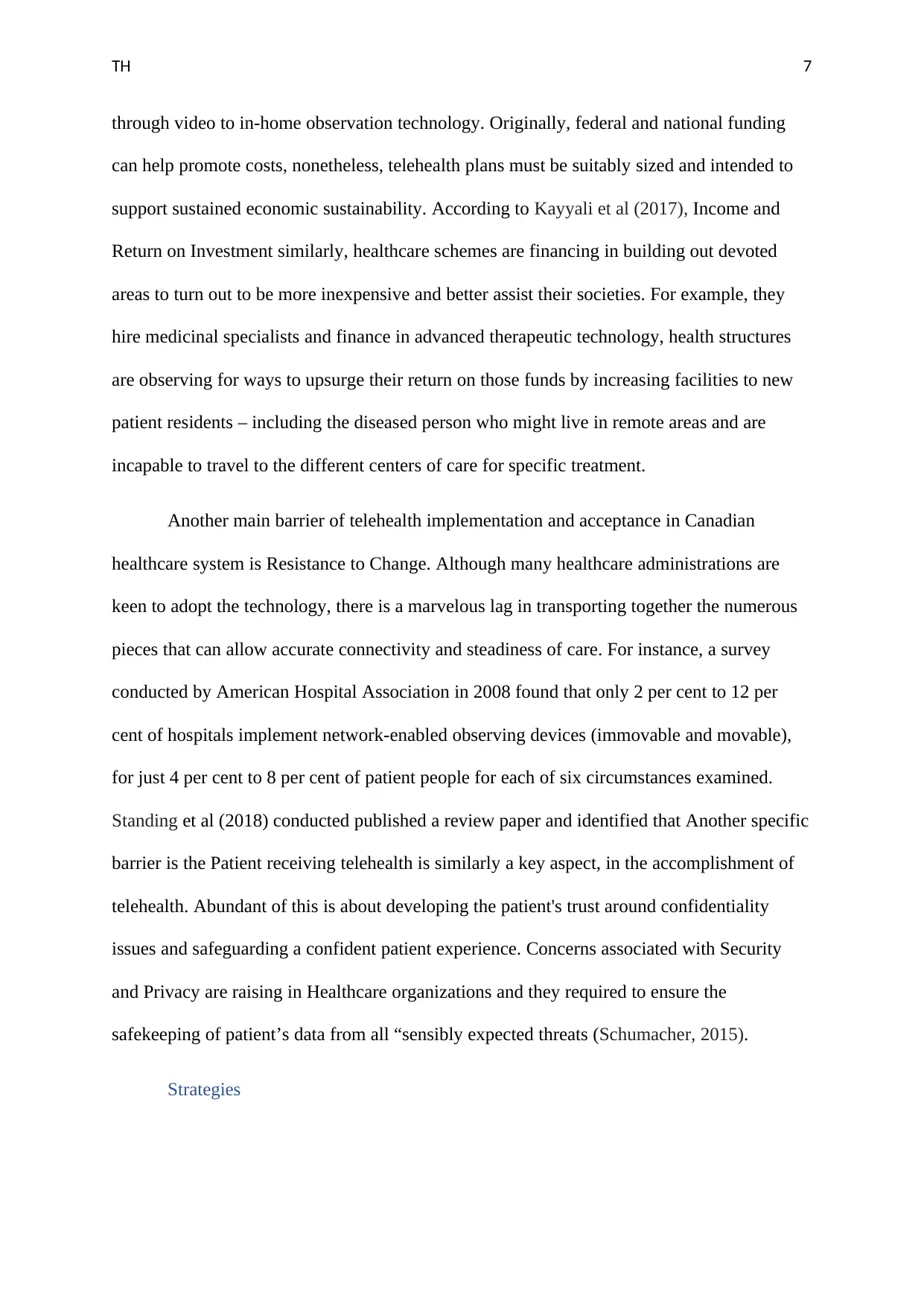
TH 7
through video to in-home observation technology. Originally, federal and national funding
can help promote costs, nonetheless, telehealth plans must be suitably sized and intended to
support sustained economic sustainability. According to Kayyali et al (2017), Income and
Return on Investment similarly, healthcare schemes are financing in building out devoted
areas to turn out to be more inexpensive and better assist their societies. For example, they
hire medicinal specialists and finance in advanced therapeutic technology, health structures
are observing for ways to upsurge their return on those funds by increasing facilities to new
patient residents – including the diseased person who might live in remote areas and are
incapable to travel to the different centers of care for specific treatment.
Another main barrier of telehealth implementation and acceptance in Canadian
healthcare system is Resistance to Change. Although many healthcare administrations are
keen to adopt the technology, there is a marvelous lag in transporting together the numerous
pieces that can allow accurate connectivity and steadiness of care. For instance, a survey
conducted by American Hospital Association in 2008 found that only 2 per cent to 12 per
cent of hospitals implement network-enabled observing devices (immovable and movable),
for just 4 per cent to 8 per cent of patient people for each of six circumstances examined.
Standing et al (2018) conducted published a review paper and identified that Another specific
barrier is the Patient receiving telehealth is similarly a key aspect, in the accomplishment of
telehealth. Abundant of this is about developing the patient's trust around confidentiality
issues and safeguarding a confident patient experience. Concerns associated with Security
and Privacy are raising in Healthcare organizations and they required to ensure the
safekeeping of patient’s data from all “sensibly expected threats (Schumacher, 2015).
Strategies
through video to in-home observation technology. Originally, federal and national funding
can help promote costs, nonetheless, telehealth plans must be suitably sized and intended to
support sustained economic sustainability. According to Kayyali et al (2017), Income and
Return on Investment similarly, healthcare schemes are financing in building out devoted
areas to turn out to be more inexpensive and better assist their societies. For example, they
hire medicinal specialists and finance in advanced therapeutic technology, health structures
are observing for ways to upsurge their return on those funds by increasing facilities to new
patient residents – including the diseased person who might live in remote areas and are
incapable to travel to the different centers of care for specific treatment.
Another main barrier of telehealth implementation and acceptance in Canadian
healthcare system is Resistance to Change. Although many healthcare administrations are
keen to adopt the technology, there is a marvelous lag in transporting together the numerous
pieces that can allow accurate connectivity and steadiness of care. For instance, a survey
conducted by American Hospital Association in 2008 found that only 2 per cent to 12 per
cent of hospitals implement network-enabled observing devices (immovable and movable),
for just 4 per cent to 8 per cent of patient people for each of six circumstances examined.
Standing et al (2018) conducted published a review paper and identified that Another specific
barrier is the Patient receiving telehealth is similarly a key aspect, in the accomplishment of
telehealth. Abundant of this is about developing the patient's trust around confidentiality
issues and safeguarding a confident patient experience. Concerns associated with Security
and Privacy are raising in Healthcare organizations and they required to ensure the
safekeeping of patient’s data from all “sensibly expected threats (Schumacher, 2015).
Strategies
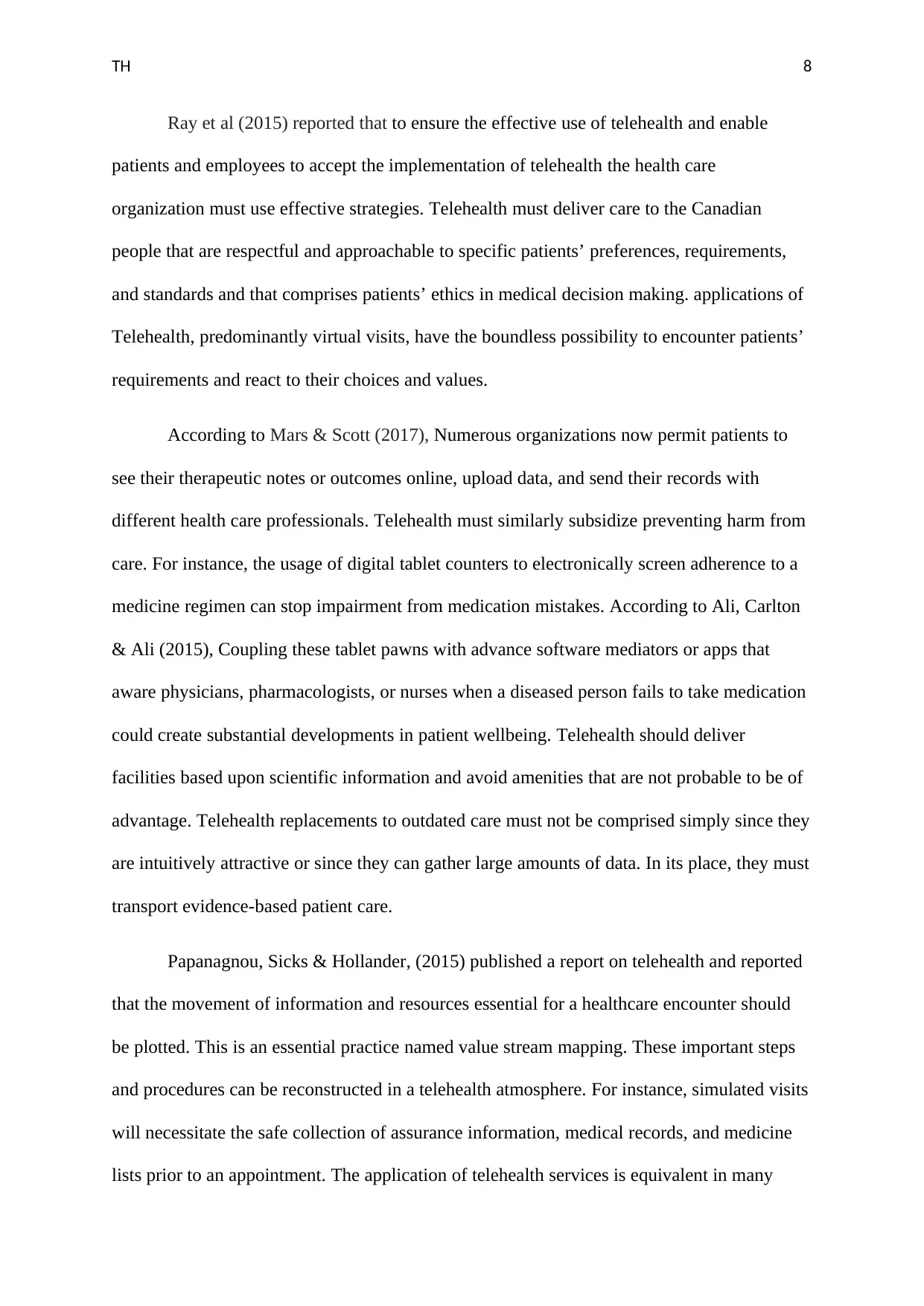
TH 8
Ray et al (2015) reported that to ensure the effective use of telehealth and enable
patients and employees to accept the implementation of telehealth the health care
organization must use effective strategies. Telehealth must deliver care to the Canadian
people that are respectful and approachable to specific patients’ preferences, requirements,
and standards and that comprises patients’ ethics in medical decision making. applications of
Telehealth, predominantly virtual visits, have the boundless possibility to encounter patients’
requirements and react to their choices and values.
According to Mars & Scott (2017), Numerous organizations now permit patients to
see their therapeutic notes or outcomes online, upload data, and send their records with
different health care professionals. Telehealth must similarly subsidize preventing harm from
care. For instance, the usage of digital tablet counters to electronically screen adherence to a
medicine regimen can stop impairment from medication mistakes. According to Ali, Carlton
& Ali (2015), Coupling these tablet pawns with advance software mediators or apps that
aware physicians, pharmacologists, or nurses when a diseased person fails to take medication
could create substantial developments in patient wellbeing. Telehealth should deliver
facilities based upon scientific information and avoid amenities that are not probable to be of
advantage. Telehealth replacements to outdated care must not be comprised simply since they
are intuitively attractive or since they can gather large amounts of data. In its place, they must
transport evidence-based patient care.
Papanagnou, Sicks & Hollander, (2015) published a report on telehealth and reported
that the movement of information and resources essential for a healthcare encounter should
be plotted. This is an essential practice named value stream mapping. These important steps
and procedures can be reconstructed in a telehealth atmosphere. For instance, simulated visits
will necessitate the safe collection of assurance information, medical records, and medicine
lists prior to an appointment. The application of telehealth services is equivalent in many
Ray et al (2015) reported that to ensure the effective use of telehealth and enable
patients and employees to accept the implementation of telehealth the health care
organization must use effective strategies. Telehealth must deliver care to the Canadian
people that are respectful and approachable to specific patients’ preferences, requirements,
and standards and that comprises patients’ ethics in medical decision making. applications of
Telehealth, predominantly virtual visits, have the boundless possibility to encounter patients’
requirements and react to their choices and values.
According to Mars & Scott (2017), Numerous organizations now permit patients to
see their therapeutic notes or outcomes online, upload data, and send their records with
different health care professionals. Telehealth must similarly subsidize preventing harm from
care. For instance, the usage of digital tablet counters to electronically screen adherence to a
medicine regimen can stop impairment from medication mistakes. According to Ali, Carlton
& Ali (2015), Coupling these tablet pawns with advance software mediators or apps that
aware physicians, pharmacologists, or nurses when a diseased person fails to take medication
could create substantial developments in patient wellbeing. Telehealth should deliver
facilities based upon scientific information and avoid amenities that are not probable to be of
advantage. Telehealth replacements to outdated care must not be comprised simply since they
are intuitively attractive or since they can gather large amounts of data. In its place, they must
transport evidence-based patient care.
Papanagnou, Sicks & Hollander, (2015) published a report on telehealth and reported
that the movement of information and resources essential for a healthcare encounter should
be plotted. This is an essential practice named value stream mapping. These important steps
and procedures can be reconstructed in a telehealth atmosphere. For instance, simulated visits
will necessitate the safe collection of assurance information, medical records, and medicine
lists prior to an appointment. The application of telehealth services is equivalent in many
⊘ This is a preview!⊘
Do you want full access?
Subscribe today to unlock all pages.

Trusted by 1+ million students worldwide
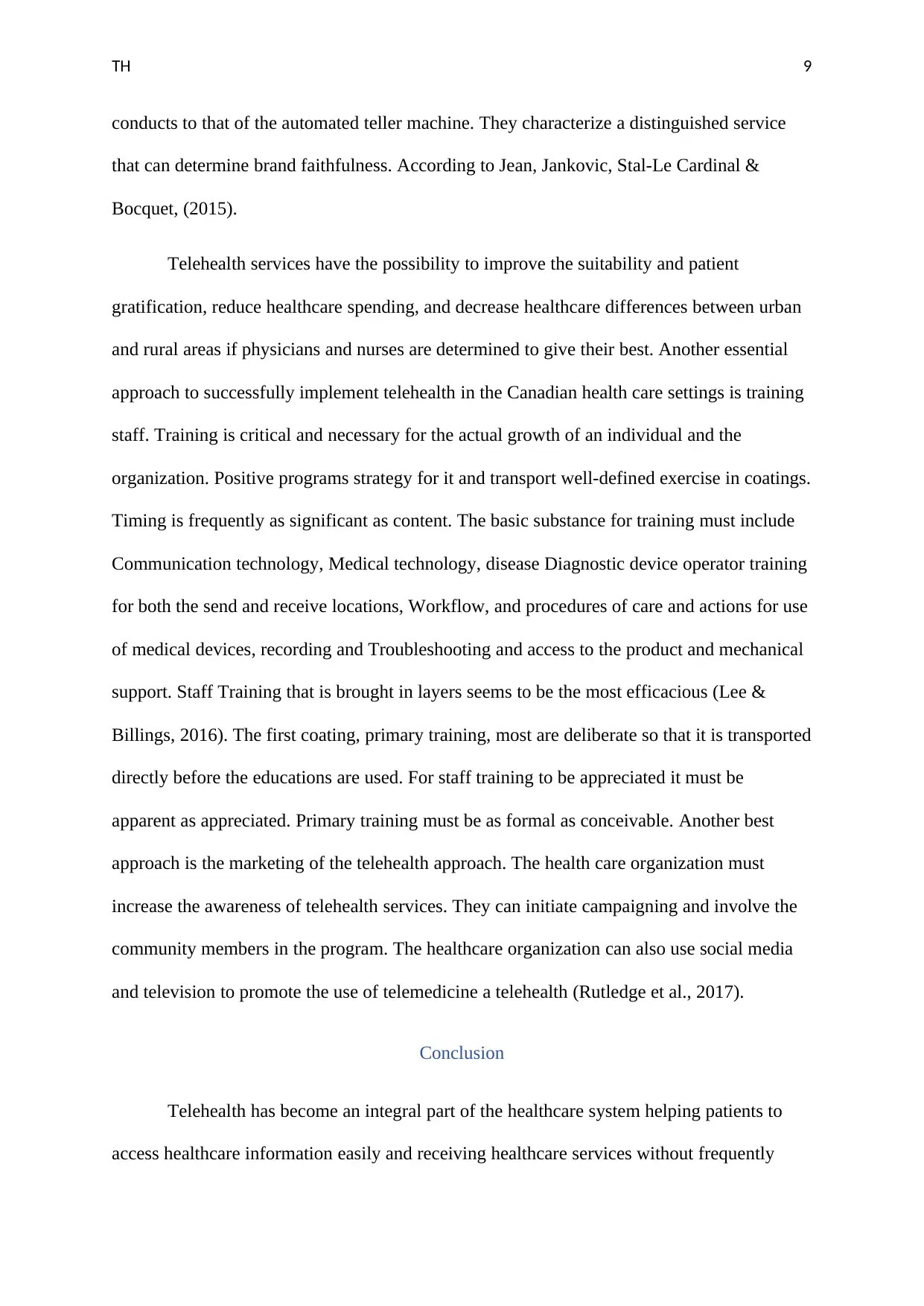
TH 9
conducts to that of the automated teller machine. They characterize a distinguished service
that can determine brand faithfulness. According to Jean, Jankovic, Stal-Le Cardinal &
Bocquet, (2015).
Telehealth services have the possibility to improve the suitability and patient
gratification, reduce healthcare spending, and decrease healthcare differences between urban
and rural areas if physicians and nurses are determined to give their best. Another essential
approach to successfully implement telehealth in the Canadian health care settings is training
staff. Training is critical and necessary for the actual growth of an individual and the
organization. Positive programs strategy for it and transport well-defined exercise in coatings.
Timing is frequently as significant as content. The basic substance for training must include
Communication technology, Medical technology, disease Diagnostic device operator training
for both the send and receive locations, Workflow, and procedures of care and actions for use
of medical devices, recording and Troubleshooting and access to the product and mechanical
support. Staff Training that is brought in layers seems to be the most efficacious (Lee &
Billings, 2016). The first coating, primary training, most are deliberate so that it is transported
directly before the educations are used. For staff training to be appreciated it must be
apparent as appreciated. Primary training must be as formal as conceivable. Another best
approach is the marketing of the telehealth approach. The health care organization must
increase the awareness of telehealth services. They can initiate campaigning and involve the
community members in the program. The healthcare organization can also use social media
and television to promote the use of telemedicine a telehealth (Rutledge et al., 2017).
Conclusion
Telehealth has become an integral part of the healthcare system helping patients to
access healthcare information easily and receiving healthcare services without frequently
conducts to that of the automated teller machine. They characterize a distinguished service
that can determine brand faithfulness. According to Jean, Jankovic, Stal-Le Cardinal &
Bocquet, (2015).
Telehealth services have the possibility to improve the suitability and patient
gratification, reduce healthcare spending, and decrease healthcare differences between urban
and rural areas if physicians and nurses are determined to give their best. Another essential
approach to successfully implement telehealth in the Canadian health care settings is training
staff. Training is critical and necessary for the actual growth of an individual and the
organization. Positive programs strategy for it and transport well-defined exercise in coatings.
Timing is frequently as significant as content. The basic substance for training must include
Communication technology, Medical technology, disease Diagnostic device operator training
for both the send and receive locations, Workflow, and procedures of care and actions for use
of medical devices, recording and Troubleshooting and access to the product and mechanical
support. Staff Training that is brought in layers seems to be the most efficacious (Lee &
Billings, 2016). The first coating, primary training, most are deliberate so that it is transported
directly before the educations are used. For staff training to be appreciated it must be
apparent as appreciated. Primary training must be as formal as conceivable. Another best
approach is the marketing of the telehealth approach. The health care organization must
increase the awareness of telehealth services. They can initiate campaigning and involve the
community members in the program. The healthcare organization can also use social media
and television to promote the use of telemedicine a telehealth (Rutledge et al., 2017).
Conclusion
Telehealth has become an integral part of the healthcare system helping patients to
access healthcare information easily and receiving healthcare services without frequently
Paraphrase This Document
Need a fresh take? Get an instant paraphrase of this document with our AI Paraphraser
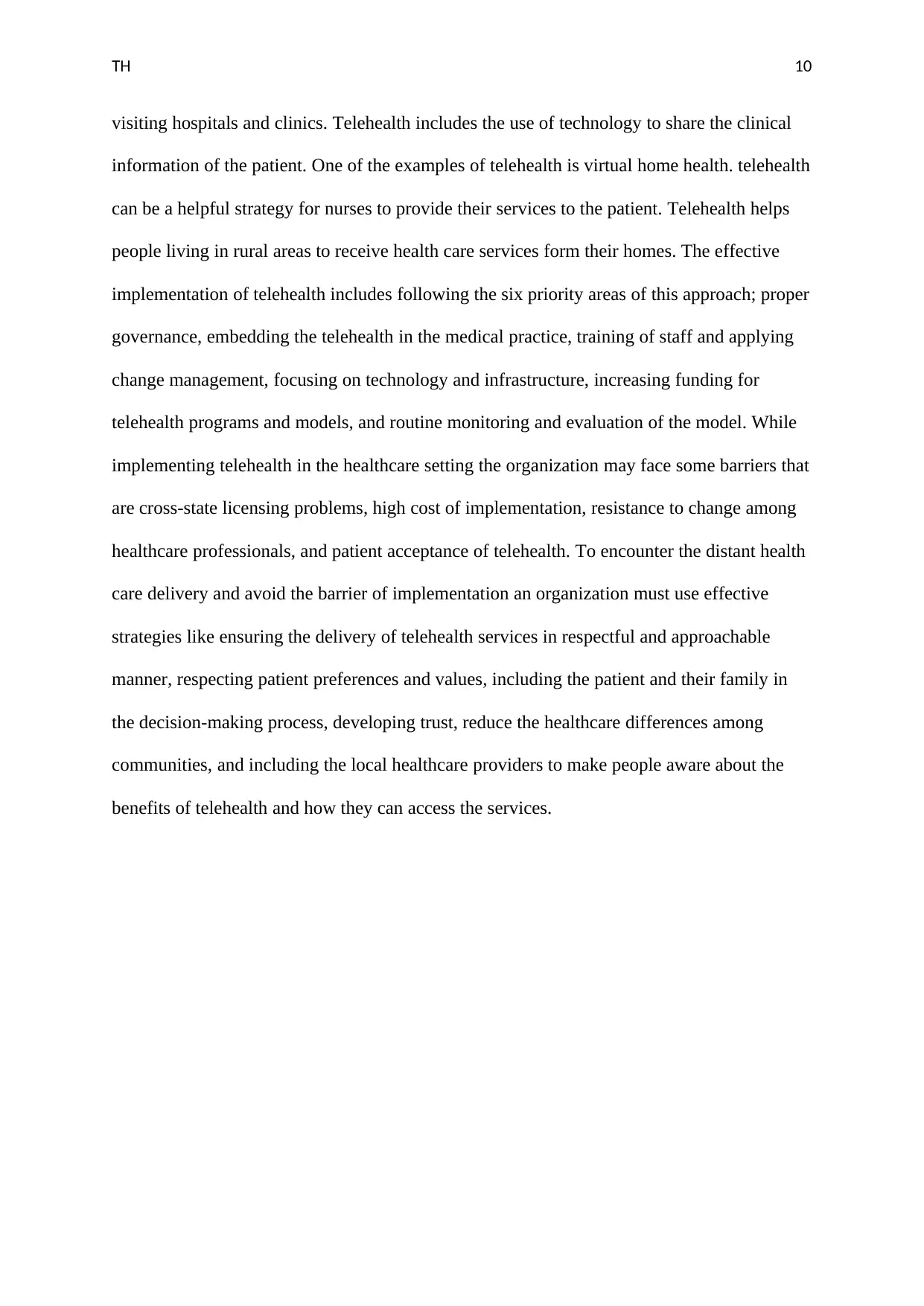
TH 10
visiting hospitals and clinics. Telehealth includes the use of technology to share the clinical
information of the patient. One of the examples of telehealth is virtual home health. telehealth
can be a helpful strategy for nurses to provide their services to the patient. Telehealth helps
people living in rural areas to receive health care services form their homes. The effective
implementation of telehealth includes following the six priority areas of this approach; proper
governance, embedding the telehealth in the medical practice, training of staff and applying
change management, focusing on technology and infrastructure, increasing funding for
telehealth programs and models, and routine monitoring and evaluation of the model. While
implementing telehealth in the healthcare setting the organization may face some barriers that
are cross-state licensing problems, high cost of implementation, resistance to change among
healthcare professionals, and patient acceptance of telehealth. To encounter the distant health
care delivery and avoid the barrier of implementation an organization must use effective
strategies like ensuring the delivery of telehealth services in respectful and approachable
manner, respecting patient preferences and values, including the patient and their family in
the decision-making process, developing trust, reduce the healthcare differences among
communities, and including the local healthcare providers to make people aware about the
benefits of telehealth and how they can access the services.
visiting hospitals and clinics. Telehealth includes the use of technology to share the clinical
information of the patient. One of the examples of telehealth is virtual home health. telehealth
can be a helpful strategy for nurses to provide their services to the patient. Telehealth helps
people living in rural areas to receive health care services form their homes. The effective
implementation of telehealth includes following the six priority areas of this approach; proper
governance, embedding the telehealth in the medical practice, training of staff and applying
change management, focusing on technology and infrastructure, increasing funding for
telehealth programs and models, and routine monitoring and evaluation of the model. While
implementing telehealth in the healthcare setting the organization may face some barriers that
are cross-state licensing problems, high cost of implementation, resistance to change among
healthcare professionals, and patient acceptance of telehealth. To encounter the distant health
care delivery and avoid the barrier of implementation an organization must use effective
strategies like ensuring the delivery of telehealth services in respectful and approachable
manner, respecting patient preferences and values, including the patient and their family in
the decision-making process, developing trust, reduce the healthcare differences among
communities, and including the local healthcare providers to make people aware about the
benefits of telehealth and how they can access the services.
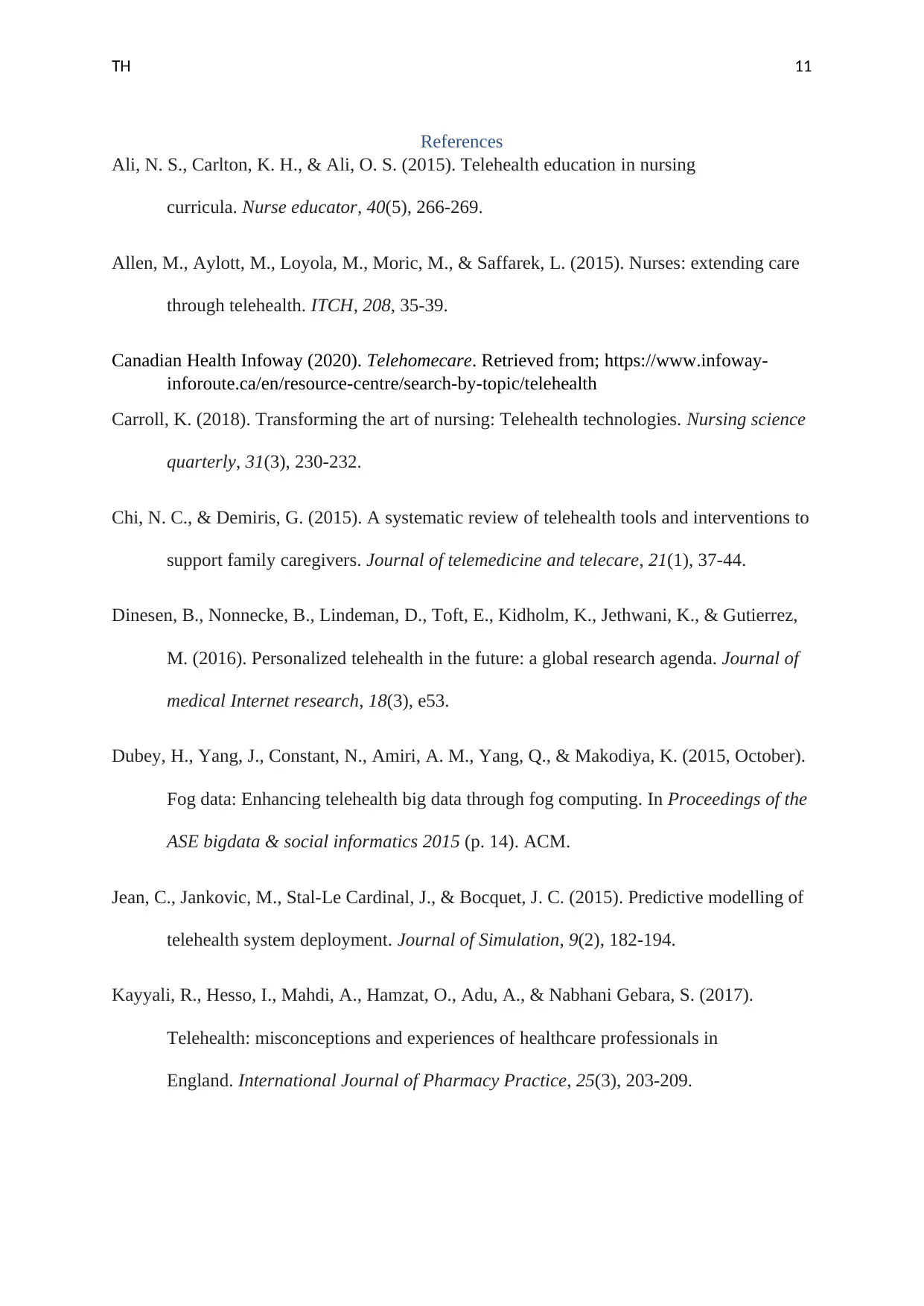
TH 11
References
Ali, N. S., Carlton, K. H., & Ali, O. S. (2015). Telehealth education in nursing
curricula. Nurse educator, 40(5), 266-269.
Allen, M., Aylott, M., Loyola, M., Moric, M., & Saffarek, L. (2015). Nurses: extending care
through telehealth. ITCH, 208, 35-39.
Canadian Health Infoway (2020). Telehomecare. Retrieved from; https://www.infoway-
inforoute.ca/en/resource-centre/search-by-topic/telehealth
Carroll, K. (2018). Transforming the art of nursing: Telehealth technologies. Nursing science
quarterly, 31(3), 230-232.
Chi, N. C., & Demiris, G. (2015). A systematic review of telehealth tools and interventions to
support family caregivers. Journal of telemedicine and telecare, 21(1), 37-44.
Dinesen, B., Nonnecke, B., Lindeman, D., Toft, E., Kidholm, K., Jethwani, K., & Gutierrez,
M. (2016). Personalized telehealth in the future: a global research agenda. Journal of
medical Internet research, 18(3), e53.
Dubey, H., Yang, J., Constant, N., Amiri, A. M., Yang, Q., & Makodiya, K. (2015, October).
Fog data: Enhancing telehealth big data through fog computing. In Proceedings of the
ASE bigdata & social informatics 2015 (p. 14). ACM.
Jean, C., Jankovic, M., Stal-Le Cardinal, J., & Bocquet, J. C. (2015). Predictive modelling of
telehealth system deployment. Journal of Simulation, 9(2), 182-194.
Kayyali, R., Hesso, I., Mahdi, A., Hamzat, O., Adu, A., & Nabhani Gebara, S. (2017).
Telehealth: misconceptions and experiences of healthcare professionals in
England. International Journal of Pharmacy Practice, 25(3), 203-209.
References
Ali, N. S., Carlton, K. H., & Ali, O. S. (2015). Telehealth education in nursing
curricula. Nurse educator, 40(5), 266-269.
Allen, M., Aylott, M., Loyola, M., Moric, M., & Saffarek, L. (2015). Nurses: extending care
through telehealth. ITCH, 208, 35-39.
Canadian Health Infoway (2020). Telehomecare. Retrieved from; https://www.infoway-
inforoute.ca/en/resource-centre/search-by-topic/telehealth
Carroll, K. (2018). Transforming the art of nursing: Telehealth technologies. Nursing science
quarterly, 31(3), 230-232.
Chi, N. C., & Demiris, G. (2015). A systematic review of telehealth tools and interventions to
support family caregivers. Journal of telemedicine and telecare, 21(1), 37-44.
Dinesen, B., Nonnecke, B., Lindeman, D., Toft, E., Kidholm, K., Jethwani, K., & Gutierrez,
M. (2016). Personalized telehealth in the future: a global research agenda. Journal of
medical Internet research, 18(3), e53.
Dubey, H., Yang, J., Constant, N., Amiri, A. M., Yang, Q., & Makodiya, K. (2015, October).
Fog data: Enhancing telehealth big data through fog computing. In Proceedings of the
ASE bigdata & social informatics 2015 (p. 14). ACM.
Jean, C., Jankovic, M., Stal-Le Cardinal, J., & Bocquet, J. C. (2015). Predictive modelling of
telehealth system deployment. Journal of Simulation, 9(2), 182-194.
Kayyali, R., Hesso, I., Mahdi, A., Hamzat, O., Adu, A., & Nabhani Gebara, S. (2017).
Telehealth: misconceptions and experiences of healthcare professionals in
England. International Journal of Pharmacy Practice, 25(3), 203-209.
⊘ This is a preview!⊘
Do you want full access?
Subscribe today to unlock all pages.

Trusted by 1+ million students worldwide
1 out of 14
Related Documents
Your All-in-One AI-Powered Toolkit for Academic Success.
+13062052269
info@desklib.com
Available 24*7 on WhatsApp / Email
![[object Object]](/_next/static/media/star-bottom.7253800d.svg)
Unlock your academic potential
Copyright © 2020–2025 A2Z Services. All Rights Reserved. Developed and managed by ZUCOL.




